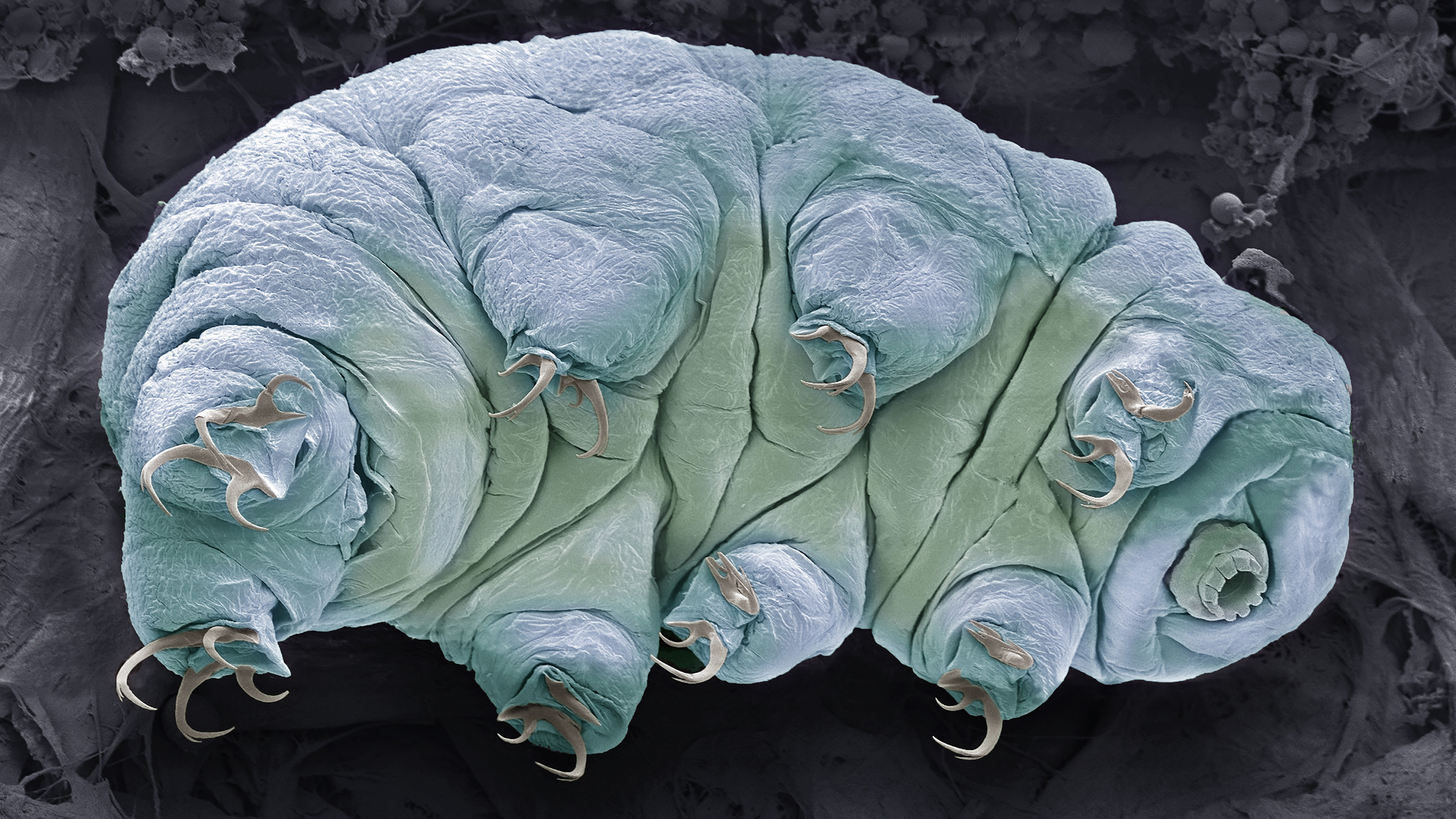Frozen tardigrade becomes first 'quantum entangled' animal in history, researchers claim
Some experts are skeptical that the frozen moss piglet really entered a quantum state.

Tardigrades — those microscopic, plump-bodied critters lovingly known as "moss piglets" — have been put through the ringer for science. The amazingly durable creatures have been shot out of guns, bathed in boiling-hot water, exposed to intense ultraviolet radiation and even (accidentally) crash-landed on the moon, all to test the limits of their impressive "tun" state — a survival mechanism wherein tardigrades curl up into shrunken, dehydrated balls and suspend their biological functions indefinitely in order to endure extreme environmental conditions.
Now, researchers have exposed tardigrades to the coldest temperatures and highest pressures that moss piglets have ever survived — not just to test the critters' biological limits, but also to see whether a frozen tardigrade could be incorporated into two quantum entangled electric circuits, then later revived to its normal active state.
The results, reported in a new paper published to the preprint database arXiv, suggest that, yes — scientists may be able to add "temporary quantum entanglement" to the tardigrade's growing list of accomplishments. However, early responses to the paper have taken issue with this finding.
If the findings ultimately withstand peer review, then this experiment will represent the first time a living animal has been quantum entangled — a bizarre phenomenon typically confined to the smallest subatomic particles.
Spooky action in a piglet
The phenomenon of quantum entanglement is so strange that even Albert Einstein had his doubts about it, famously nicknaming the process "spooky action at a distance." Essentially, the effect occurs when two teeny, tiny subatomic particles become bound to one another so that a change to one particle's spin or momentum instantaneously changes the other particle in the same way — even when the two particles are separated by incredibly large distances.
This effect may be able to transcend the subatomic realm, as scientists attempted to prove in a 2018 paper in the Journal of Physics Communications. That team found that certain photosynthetic bacteria were capable of becoming entangled with light photons, when the resonant frequency of light in a mirrored room eventually synchronized with the frequency of electrons in the bacteria's photosynthetic molecules, Live Science previously reported.
The authors of the new arXiv paper decided to test whether a multicellular organism like a tardigrade could develop such a relationship. In their experiment, the team collected three tardigrades from a roof gutter in Denmark. In their animated state, the tardigrades measured between 0.008 and 0.018 inches (0.2 to 0.45 millimeters) — however, after the researchers froze the tardigrades and sent them into a tun state, the animals shrunk to about a third of that size.
Sign up for the Live Science daily newsletter now
Get the world’s most fascinating discoveries delivered straight to your inbox.
From there, the team froze the tardigrades even further, cooling them to a fraction of a degree above absolute zero — the coldest temperature a tardigrade has ever been exposed to and survived.
The team placed each frozen tardigrade between two capacitor plates of a superconductor circuit that formed a quantum bit, or "qubit" — a unit of information used in quantum computing. When the tardigrade came into contact with the qubit (named Qubit B), it shifted the qubit's resonant frequency. That tardigrade-qubit-hybrid was then coupled to a second nearby circuit (Qubit A), so that the two qubits became entangled. Over several tests that followed, the researchers saw that the frequency of both qubits and the tardigrade changed in tandem, resembling a three-part entangled system.
Seventeen days after the tardigrades entered their tun states, the researchers gently warmed them up in an attempt to revive them. One of the tardigrades returned to its animated state, while the other two died. That survivor effectively has become the first quantum entangled animal in history, the researchers claimed.
"While one might expect similar physical results from inanimate objects with similar composition to the tardigrade, we emphasize that entanglement is observed with [an] entire organism that retains its biological functionality post experiment," the team concluded in their paper. "At the same time, the tardigrade survived the most extreme and prolonged conditions it has ever been exposed to."
While the paper has not yet been peer-reviewed, early responses from the scientific community have been critical. Douglas Natelson, Department Chair of physics and astronomy at Rice University in Texas, wrote on his blog that the experiment "did not entangle a tardigrade with a qubit in any meaningful sense."
"What the authors did here was put a tardigrade on top of the capacitive parts of one of two coupled qubits," Natelson wrote. "The tardigrade is mostly (frozen) water, and here it acts like a dielectric, shifting the resonance frequency of the one qubit that it sat on… This is not entanglement in any meaningful sense."
Ben Brubaker, a science writer and former physicist agreed.
"The qubit is an electrical circuit and putting the tardigrade next to it affects it through the laws of electromagnetism we've known about for more than 150 years," Brubaker tweeted. "Putting a speck of dust next to the qubit would have a similar effect."
Whether or not the tardigrade experienced any "spooky action" from the qubits it was attached to, the study does show that moss piglets are even more durable than previously thought. As exciting as a "quantum tardigrade" sounds, this experiment should at least serve as a reminder that regular-old tardigrades are fascinating enough on their own.
Originally published on Live Science.

Brandon is the space/physics editor at Live Science. His writing has appeared in The Washington Post, Reader's Digest, CBS.com, the Richard Dawkins Foundation website and other outlets. He holds a bachelor's degree in creative writing from the University of Arizona, with minors in journalism and media arts. He enjoys writing most about space, geoscience and the mysteries of the universe.









